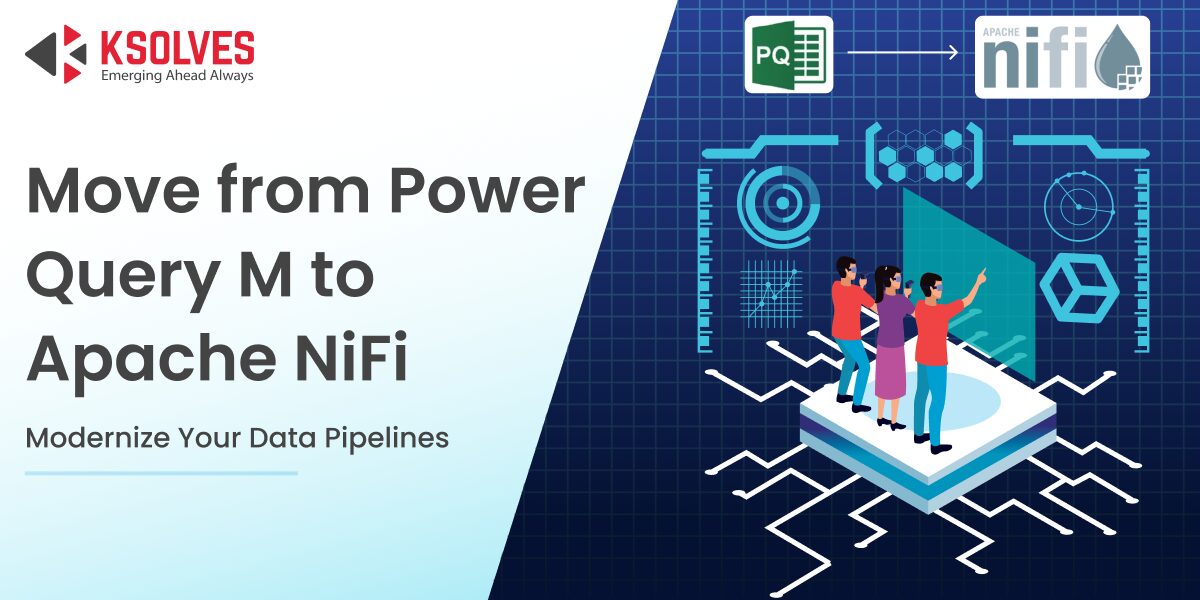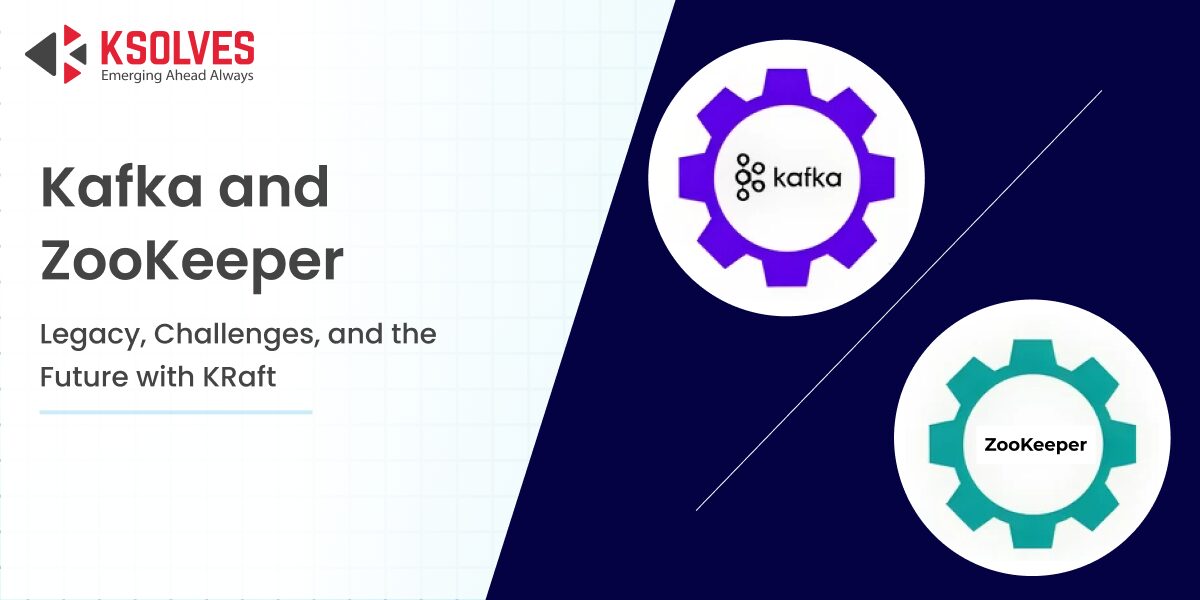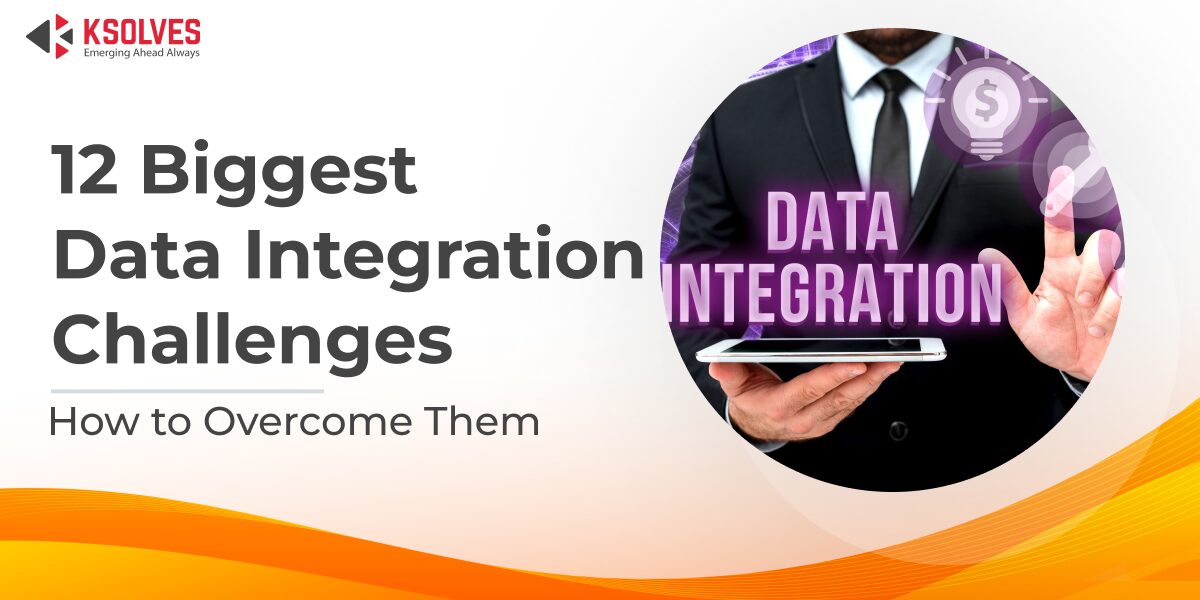Migrating from Power Query M to Apache NiFi: A Practical Guide
Big Data
5 MIN READ
November 12, 2025
![]()

In the era of data-driven decision-making, businesses can’t afford bottlenecks in how they collect and transform data. Power Query M, or the M language, while excellent for shaping data in Power BI or Excel, was never built for large-scale, automated operations. It shines on the desktop but struggles in the data center.
As data volumes surge and integration points multiply, those once-handy M scripts start showing their limits: manual refreshes, rigid workflows, and minimal orchestration.
That’s where Apache NiFi takes the stage, which is a flow-based, enterprise-grade platform designed for real-time, automated, and scalable data pipelines. Migrating from Power Query M to NiFi helps teams turn manual data prep into production-ready workflows that seamlessly connect databases, APIs, data lakes, and analytics systems.
This blog walks you through a detailed guide on migrating from Power Query M to Apache NiFi.
Power Query and the M Language
Power Query is Microsoft’s data connection and transformation engine, embedded across tools like Power BI, Excel, and Dataverse. It leverages the M language, which is a functional, case-sensitive scripting language designed specifically for data extraction, transformation, and loading (ETL) within self-service analytics environments.
Key Capabilities:
- Connects seamlessly to diverse data sources, including Excel, SQL Server, Web APIs, and SharePoint.
- Enables rich data shaping through operations like filtering, joins, merges, and pivot/unpivot transformations.
- Allows users to combine and prepare data interactively using either the graphical interface or custom M expressions.
Limitations:
- Executes primarily within desktop or Power BI service environments – not ideal for large-scale automation.
- Offers no native scheduling, orchestration, or real-time data streaming capabilities.
- Provides limited integration options outside the Microsoft ecosystem.
- Lacks advanced debugging, version control, and scalability features required for enterprise-grade data pipelines.
Apache NiFi Overview
Apache NiFi is an open-source, enterprise-grade platform for data flow automation and orchestration, purpose-built to move, transform, and manage data between systems at any scale.
Originally developed by the U.S. National Security Agency (NSA) and now maintained by the Apache Software Foundation, NiFi enables organizations to design, monitor, and control complex dataflows with ease and transparency.
Key Features:
- Visual flow design: Drag-and-drop interface for building and managing data pipelines without coding.
- Real-time and batch processing: Seamlessly handles both streaming and scheduled data ingestion.
- Extensive processor library: Hundreds of built-in processors for data collection, transformation, and routing across diverse systems.
- Data provenance: Complete visibility and traceability of every data event through built-in lineage tracking.
- Fine-grained control: Configure prioritization, backpressure, and retries for reliable and efficient data movement.
- Custom extensibility: Supports scripting in Python, Groovy, or JavaScript and integration with external libraries or APIs.
Common Use Cases:
- Building data ingestion pipelines from APIs, databases, files, or IoT devices.
- Implementing real-time ETL/ELT workflows for analytics and operational reporting.
- Integrating with data lakes, Kafka, Hadoop, and cloud storage platforms.
- Enforcing data governance, lineage, and compliance across distributed environments.
When and Why to Migrate
Organizations typically consider migrating from Power Query M to Apache NiFi when their data operations outgrow desktop-scale limitations and require enterprise-grade automation, scalability, and integration. While Power Query serves well for interactive analysis, NiFi enables continuous, governed, and high-throughput data movement across complex ecosystems.
Key Drivers for Migration:
- Scalability: NiFi’s clustered, distributed architecture can process terabytes of data daily while maintaining high availability and fault tolerance.
- Automation: Eliminate manual refresh cycles with fully automated, event-driven dataflows.
- Integration: Move data seamlessly across APIs, RDBMS, files, message queues, and cloud storage using NiFi’s extensive processor library.
- Governance: Ensure complete visibility and compliance through NiFi’s built-in data provenance, lineage, and auditing capabilities.
- Operationalization: Streamline deployment and versioning with NiFi Registry, parameter contexts, and REST API integration for CI/CD pipelines.
Example Migration Scenarios:
- Automating Power BI data refresh logic using NiFi to continuously feed updated datasets.
- Replacing manual M-based transformations with NiFi-driven ETL pipelines that run on schedule or trigger events.
- Integrating multiple data sources, from on-prem databases to cloud services, into a unified data lake for advanced analytics.
Mapping Power Query Concepts to NiFi Components
| Power Query Concept | NiFi Equivalent | Purpose |
| Data Source (Excel, SQL, API) | GetFile, QueryDatabaseTable, InvokeHTTP | Reading structured/unstructured data |
| Applied Steps (Transformations) | Processor chains (e.g., ConvertRecord, ReplaceText, UpdateAttribute) | Apply filters, merges, and transformations |
| M Functions | Script processors (ExecuteScript, ExecuteGroovyScript, ExecutePythonScript) | Custom logic, derived columns |
| Combined Queries | NiFi Process Groups or MergeRecord | Combine multiple flows |
| Output to Power BI | PutDatabaseRecord, PutFile, PutS3Object | Write to databases or storage |
| Parameters | NiFi Parameter Contexts | Dynamic configuration for reusability |
| Refresh / Schedule | NiFi Flow Scheduler or CRON-driven triggers | Automated pipeline runs |
Example:
In Power Query, you might use:
m = Table.SelectRows(Source, each [Region] = “Europe”)
In NiFi, you’d replace this with:
Processor: QueryRecord
SQL Query: SELECT * FROM FLOWFILE WHERE Region = ‘Europe’
Challenges of Migrating from Power Query M to Apache NiFi
Migrating from Power Query M to Apache NiFi isn’t a direct lift-and-shift exercise. It involves rethinking how transformations, dataflows, and dependencies are handled in a distributed environment. Organizations often face challenges such as:
Logic Translation: Converting complex, nested M expressions into NiFi processor-based flows or scripted processors.
- Schema Handling: Managing data type mismatches and enforcing schema consistency across heterogeneous sources.
- Authentication and Connectivity: Replacing Power Query’s built-in connectors and credentials with NiFi-compatible authentication methods for APIs, databases, and gateways.
- Orchestration Complexity: Designing end-to-end pipelines with appropriate routing, backpressure handling, and error recovery.
- Testing and Validation: Ensuring that transformed outputs from NiFi match the accuracy, granularity, and business rules defined in M queries.
- Operational Governance: Implementing robust monitoring, access control, and version management in the new environment.
These challenges require both technical precision and architectural foresight to ensure a smooth transition without disrupting existing analytics pipelines.
How Ksolves Simplifies Power Query to NiFi Migration
At Ksolves, as a trusted NiFi development company, we help organizations navigate this transition with a methodical and automation-driven approach. Our NiFi experts start by reverse-engineering existing M queries to identify transformation logic, dependencies, and data mappings.
We then design equivalent NiFi pipelines that not only replicate existing functionality but also enhance it through scalability, reusability, and real-time integration.
By leveraging pre-built templates, parameter contexts, and CI/CD-ready deployment practices, Ksolves ensures that your migration is low-risk, fast-tracked, and future-ready.
From initial assessment to production rollout, we streamline every phase, ensuring your data pipelines evolve from manual refreshes to continuous, enterprise-grade automation.
Ksolves’ Phased Approach to Migrate from Power Query M to Apache NiFi
Migrating from Power Query M to Apache NiFi requires a structured, step-by-step approach that ensures accuracy, scalability, and reliability. Below is a comprehensive migration roadmap covering assessment through deployment.
1. Assessment Phase
The first step is to understand your existing Power Query landscape and evaluate migration readiness.
- Inventory M Queries: Document all queries, their data sources, applied transformations, and interdependencies.
- Categorize Workflows: Group queries based on their purpose – extraction, transformation, joins, aggregations, and data loading.
- Assess Connectivity: Identify data source types, authentication mechanisms (e.g., OAuth, API keys, database credentials), and gateway dependencies.
- Define Outputs: Determine the target systems, such as databases, files, data lakes, or downstream BI tools.
This phase helps you identify transformation complexity and potential integration challenges before flow design begins.
2. Design Phase
Translate the logic of Power Query workflows into modular, scalable NiFi dataflows.
- Flow Architecture: Break down the design into logical layers for clarity and maintainability:
- Data Ingestion Layer: Use processors like GetFile, QueryDatabaseTable, and InvokeHTTP for source connections.
- Transformation Layer: Apply transformations via ConvertRecord, UpdateRecord, or JoltTransformJSON.
- Routing Layer: Implement conditional logic with RouteOnAttribute or RouteOnContent.
- Load Layer: Deliver processed data using PutDatabaseRecord, PutFile, or PutKafka.
- Schema Definition: Define record schemas using Avro or JSON Schema to maintain data consistency.
- Process Group Planning: Create reusable process groups for modular design and simplified maintenance.
3. Implementation Phase
Convert design blueprints into functional NiFi pipelines.
- Configure source processors for databases, APIs, or files.
- Apply transformations using record processors to modify structure, data types, or field names.
- Add routing and filtering logic based on attributes, metadata, or content rules.
- Write processed data to the designated targets such as databases, filesystems, or cloud storage.
- Use Parameter Contexts to manage environment variables and credentials securely.
- Enable Provenance Reporting Tasks to capture lineage and audit trail information for every flowfile.
4. Validation and Testing
Ensure that migrated workflows deliver accurate and reliable results.
- Compare Outputs: Validate NiFi results against the original Power Query outputs for parity.
- Schema Validation: Verify data types, field names, and schema structures for consistency.
- Data Provenance Inspection: Use NiFi’s built-in provenance tools to trace records through the flow and debug issues.
- Performance Testing: Conduct load and stress tests to evaluate throughput, latency, and fault tolerance.
5. Deployment
Once validated, deploy the flows into production with full version control and governance.
- Version Control: Store and manage flow versions in NiFi Registry for rollback and audit tracking.
- Automation: Use NiFi CLI or REST APIs for CI/CD-based deployments and environment promotion.
- Scheduling: Configure flow triggers through NiFi’s internal scheduler or integrate with external orchestrators like Apache Airflow or Control-M.
- Security Configuration: Enforce enterprise-grade security by enabling SSL/TLS, access policies, and user authentication mechanisms.
Benefits of Ksolves’ Phased Migration Approach
- Reduced Migration Risk: By following a stepwise approach, from assessment to deployment, we mitigate operational risks and ensure each stage is validated before progressing to the next.
- Functional Parity and Accuracy: Our validation framework ensures that every transformation, join, and aggregation in Power Query is accurately replicated and verified within NiFi. This guarantees end-to-end data consistency.
- Faster Time-to-Value: Through reusable templates, parameter contexts, and automation scripts, we accelerate migration timelines without compromising quality or control.
- Scalable, Future-Proof Architecture: The resulting NiFi pipelines are modular, cluster-ready, and designed to grow with your data ecosystem, enabling integration with data lakes, Kafka, or cloud storage platforms.
- Strong Governance and Observability: With NiFi Registry, provenance tracking, and centralized parameter management, your dataflows become more transparent, auditable, and easier to maintain.
- Seamless CI/CD Integration: Our DevOps-aligned deployment model ensures NiFi flows are versioned, tested, and released automatically across environments, supporting agile, production-grade delivery.
Final Words
Migrating from Power Query M to Apache NiFi represents a step toward automated, scalable, and enterprise-grade data integration. While Power Query excels at self-service data preparation, NiFi empowers organizations to operationalize those same transformations across production environments with real-time control, governance, and flexibility.
By adopting a phased, strategy-driven migration approach, enterprises can ensure zero data loss, maintain transformation fidelity, and unlock the full potential of NiFi’s flow-based automation. At Ksolves, we specialize in making this transition seamless, from mapping existing M logic to deploying robust, reusable NiFi pipelines that evolve with your business needs.
Make your data workflows smarter. Migrate to NiFi with Ksolves.
![]()







AUTHOR
Big Data
Anil Kushwaha, Technology Head at Ksolves, is an expert in Big Data. With over 11 years at Ksolves, he has been pivotal in driving innovative, high-volume data solutions with technologies like Nifi, Cassandra, Spark, Hadoop, etc. Passionate about advancing tech, he ensures smooth data warehousing for client success through tailored, cutting-edge strategies.
Share with